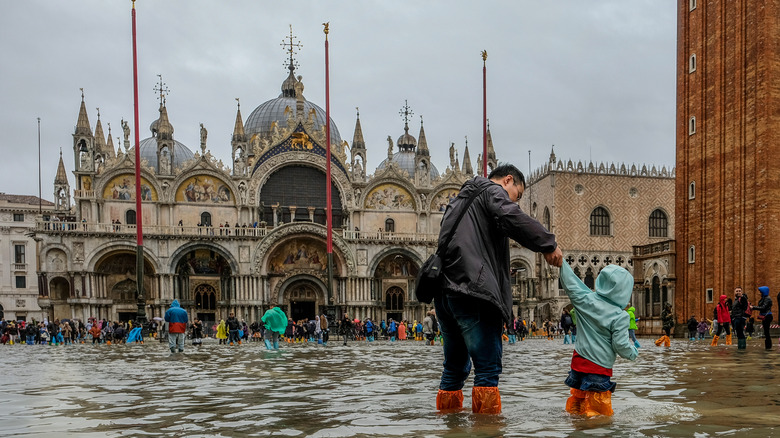What Really Is Last Chance Tourism And Why Is It So Controversial?
In recent years, a new trend has emerged in the travel industry, known as "last chance tourism" (LCT). However, "last chance" doesn't mean "final sale deal" or anything like that. LCT involves purposefully traveling to bucket list destinations that are disappearing or drastically changing by the day due to climate change, pollution, and, paradoxically, over-tourism. This controversial travel phenomenon amplifies the urgency of environmental and ethical issues worldwide under the guise of education and conservation. What's the catch?
Last chance tourism targets locations that are either endangered or deteriorating due to human activity and natural causes. Ironically, the very act of visiting these fragile destinations exacerbates their decline — a double-edged sword. Common examples include the melting Arctic glaciers, the shrinking Dead Sea, and countries facing rising water levels, such as the Maldives, Tuvalu, and Antigua. Two million people visit the slowly dying and bleached Great Barrier Reef every year. According to research published in the Journal of Sustainable Tourism, around 70% of these travelers have strong motivation to see the reef "before it's gone." Yet, few tourists perceive their travel there as harmful.
Several influences contribute to the popularity of last chance tourism. The primary driver? FOMO (fear of missing out) — a perceived urgency to witness these sites before they disappear forever. As media coverage of environmental degradation increases, so does the public's desire to witness these changes firsthand. On a less selfish note, another factor is the growing awareness of these issues and a desire to help through conservation or climate action programs.
The controversy surrounding LCT
There is an ethical dilemma inherent in LCT. The desire to witness a disappearing landscape or an ecosystem facing doomsday raises questions about the motivations and responsibilities of tourists. According to UNESCO, 56 properties have been identified as being in danger by the World Heritage Committee — from Madagascar's rainforests to Everglades National Park. Are visitors genuinely concerned about the plight of these destinations, or are they simply ticking off a box on their travel list?
The carbon footprint resulting from travel, especially air travel, significantly contributes to climate change. Case in point — the polar bear capital of the world, Canada's Churchill. A northbound rush to see these magnificent animals in their natural habitat resulted in 23,017 tonnes of emissions in the 2018 polar bear viewing season, a steady climb from the years before. Foot traffic and human activity can cause increased habitat destruction and pollution, making the situation even worse.
For many endangered destinations, LCT is a catch-22. While it brings much-needed revenue and attention to the area, it also leads to over-tourism, which strains local resources and infrastructure. Italy's Venice may ring a bell. The floating city is now a sinking city due to severe floods and "acqua alta," or high water. Some experts say it will be completely submerged by 2100. In places such as Machu Picchu, Australia's sacred Uluru, and the Arctic, where indigenous communities are affected by these changes, there is a risk that LCT can become intrusive or culturally insensitive.
The future of last chance tourism
Despite the apocalyptic gloom, proponents of last chance tourism argue that it raises awareness about environmental issues and can lead to increased conservation efforts. By witnessing the impacts of ecological degradation firsthand, tourists may become more informed and motivated to engage in sustainable practices. A 2022 study demonstrates that people participate in philanthropy more after engaging in this type of travel. If managed responsibly, LCT can be a powerful tool for environmental advocacy and, in a twisted turn, help save the very places it's affecting.
The key to resolving the controversy of last chance tourism lies in mindful travel practices. This includes choosing eco-friendly transportation options, respecting local ecosystems and cultures, and supporting conservation efforts in the destinations visited. Regenerative travel, the latest travel trend that takes sustainable tourism a step further, is a good place to start. The tourism industry and travelers alike have a responsibility to minimize their environmental burden and promote the preservation of these vulnerable sites.
The future is uncertain — as environmental issues continue to escalate, the number of destinations classified as "last chance" will likely increase. "Once an ecosystem has been destroyed it can't easily be brought back. What we don't seem to realize is that development is irreversible," explains TMU professor and sustainability advisor Rachel Dodds (via The Independent). Perhaps as travelers and explorers of the world, we all have to figure out for ourselves if contributing to that "last chance" with our own footprint is really worth it.


